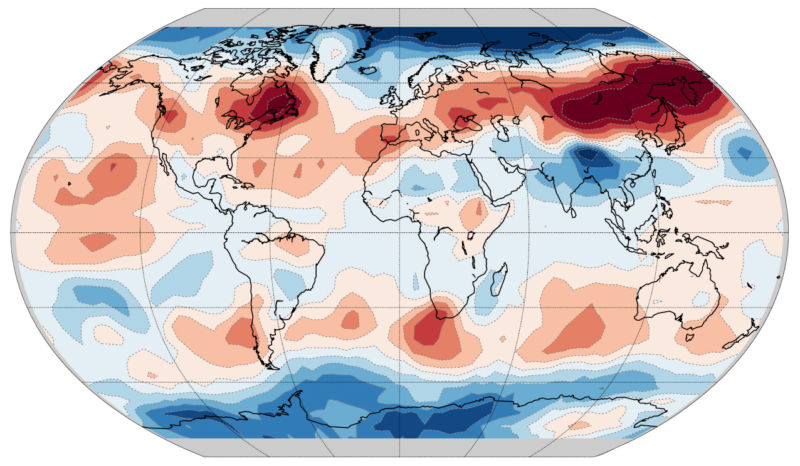Climatologists have shown how humanity influences seasonal variations in atmospheric temperature.

Climatologists from the Livermore National Laboratory. E. Lawrence (LLNL) recently published a report on work to find traces of human influence on climate. Actually, it’s not necessary to look for it yourself - the changes are already visible with the naked eye. But for climatologists, it is important to prove that certain changes are caused by human activity.
In the course of their work, specialists studied data from six satellite systems that transmit information on the state of climate since 1979. The sample is large enough to track changes of almost any scale. An additional task was to separate the influence of natural and anthropogenic factors on what is happening on our planet.
The difference of this study from all others is the study of a specific set of data on the temperature of the atmosphere. The main two parameters that interested specialists were the average annual temperature of the troposphere and the amplitude of temperature fluctuations during the year (thus, the difference between the average temperature of the warmest and coldest months of the year is studied).
So, scientists began to measure the magnitude of the annual seasonal cycle. During the study, interesting patterns emerged (the preview image is their visualization).
On the continents of the Northern and Southern Hemispheres, the amplitude of oscillations increases. Since the end of the last century, data show that the temperature difference in summer and in winter is becoming more and more noticeable. The summer is getting hotter, the winter is colder. This mainly applies to land. The reason, according to experts, is greenhouse gas emissions. By the way, in the tropics the natural flow of seasonal cycles has also changed. But at the poles, on the contrary, the temperature fluctuations decreased. As for the tropical and equatorial latitudes, the activity of changes in the seasonal cycle also decreased.

The average annual temperature of the troposphere (right) and the amplitude of temperature changes during the year (left)
As it turned out, the models almost completely coincided with the situation predicted by scientists. Namely, higher seasonal variations in midlatitudes (especially for the Northern Hemisphere), small changes in the tropics and smaller variations in the Antarctic. Models also correctly predict smaller fluctuations in temperature in the summer and winter in India and Southeast Asia.
In addition, in the Arctic, satellite data show a stronger decline in the seasonal cycle than the projected average model. Approximately one third of the models show a decline, but the rest is not. Models tend to underestimate the loss of Arctic sea ice, and perhaps this is the key, since sea ice melting is an important factor in changing the seasonal cycle.
To test how strongly the changes observed by the satellite point to human-induced warming, the researchers used a signal-to-noise analysis. Using simulations before the industrial revolution to estimate the range of natural variability, the analysis showed that the observed seasonal patterns in the middle troposphere clearly exceeded the noise. This makes them a clear manifestation of the models predicted by the models. This is even clearer than the change in world average temperatures, in fact, because seasonal patterns in all ranges of latitude will not differ much in a stable climate.
While they were on it, the researchers repeated these analyzes to more directly measure climate change: annual average temperature analyzed in locations around the world. They write: “We find here that for average annual environments [temperatures in the middle of the troposphere], the calculated signal-to-noise ratios exceed 4.4 for temperature changes over a 38-year satellite recording. This leads to a ratio of about 5 to 1 million from obtaining the average signal-to-noise ratio only by natural variability. "
The main task was to obtain confirmation of a statistically significant relationship between changes in seasonal cycles of the temperature of the troposphere and the influence of anthropogenic factors. And confirmation was obtained: for five of the six data sets, the existence of a link was proved. The probability of error does not exceed 1%. There is simply no significant increase in error, even with averaging data over 10–20 years.
According to experts, the information obtained will make it possible to develop more effective than now methods for analyzing climate data and possible mitigation of the effects of anthropogenic influence.
In addition to the troposphere, there are other signs of changes in seasonal cycles and even changes in the seasons. Relatively recently, scientists have found that in the mountains, the time of the seasons change with time is equalized in height. But the relationship between the increase in average annual air temperature and the shift of seasons is not always obvious. For example, climatologists have noticed that the earlier melting of snow, which is a direct consequence of global warming, leads to an increase in the absorption of atmospheric carbon dioxide in the taiga.
